Serendip is an independent site partnering with faculty at multiple colleges and universities around the world. Happy exploring!
Brain Behavior Institute - Session 19
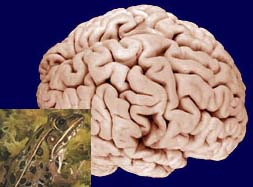 |
BRAIN AND BEHAVIOR INSTITUTE 2009 |
 |
The Brain: Significance for Education?
Review and on
WOW....Everything I say and do is always wrong and subject to looking at it differently! ... Jack
I am still grappling with that dissonance ... Jill
When I was in fifth grade (or so) my Mother asked me why I did something. I responded “I thought …. “ She asked me “Who is paying you to think?” I responded “You are paying all of that money to send me to a Christian school, so you are really paying me to think.” ... Antoinette
Memory, self, reality as story Two loops, each important- inside/outside (extrapersonal)
- unconscious/story teller (intrapersonal)l
Learn/create from noticing discrepancies between expectations and input in each, changing to get it less wrong
Fear of failure change by the story teller’s story from “I can not” to “I can” by a new set of observations and a new symphony that can be created and revised ... Lucienne et al
a more effective approach [to learned helplessness] seems to be to help the child tell a new story. The child needs new experiences in order to create a new story. Could trying to associate the situation with a new emotion help as well?? ... Jill et al
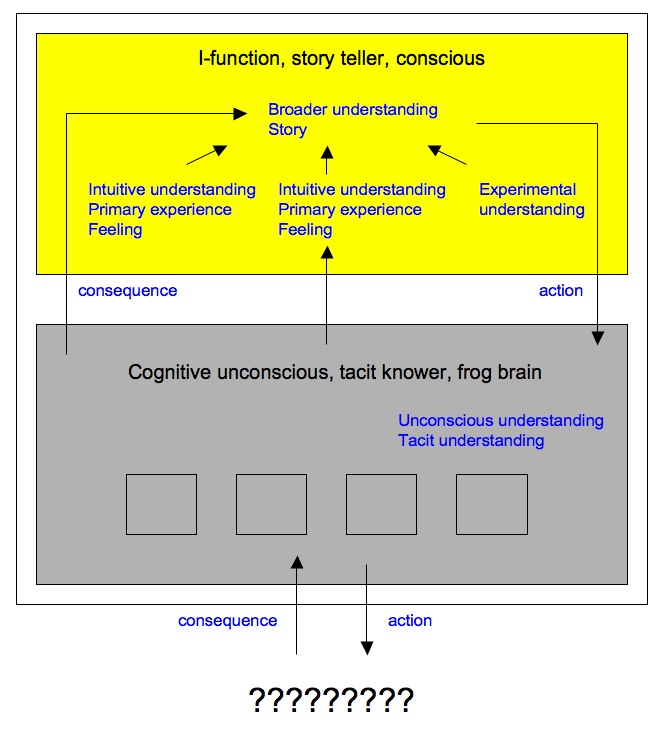
Distributed system - balance of powers
"No one has written your destiny for you" ... Barack Obama
"The problems of human destiny are not beyond the reach of human beings" ... John F. Kennedy
The other potentially successful method (for dealing with "bullying") could be to develop strategies that the victim might accept so as to diffuse the irritation of others (in their cognitive unconscious) and create better balance around her ... Joyce et al
do our stories serve any purpose as we interact with each other? ... Deb
The bipartite brain and culture
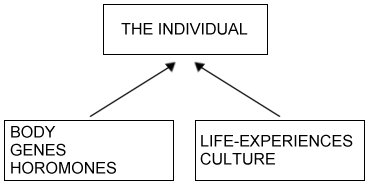
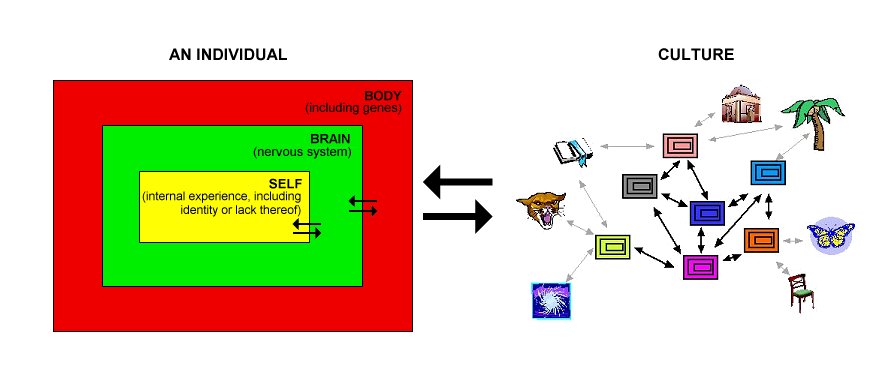
from The Brain and Social Organization
Interacting individual and cultural stories
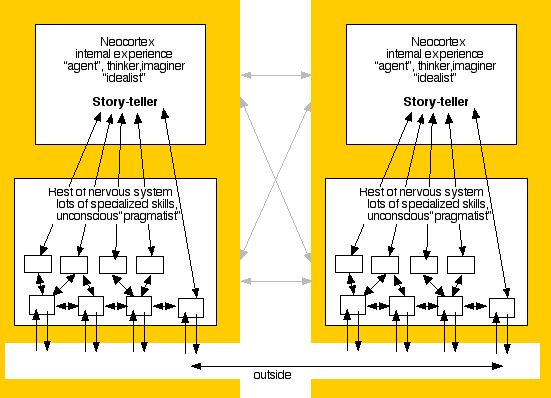 Advantages and challenges of the bipartite brain
Advantages and challenges of the bipartite brain
Sharing the process with others, learning to enjoy the dissonance
Learning to live with/enjoy the bipartite brain
Writing Descartes: I Am and I Can Think, Therefore ...Paths to Story Telling As Life
- Genes are valuable, but don't take them too seriously
- Experiences are valuable, but don't take them too seriously
- Feelings are valuable, but don't take them too seriously
- Cultural stories are valuable, but don't take them too seriously
- Personal stories are valuable, but don't take them too seriously
- Stop looking for the "answer" and look instead for what's "less wrong," for new directions to create
Bottom line of story of brain=behavior:
- Believe in where one is, has come from (including genes)
- Challenge self/others, dream/imagine/create
- Share stories
- Repeat over and over again
and what I find around me
Addition
Story doesn't mean "lie" or "to be ignored", means tentative/revisable
One is never "trapped", there are always ways to get it less wrong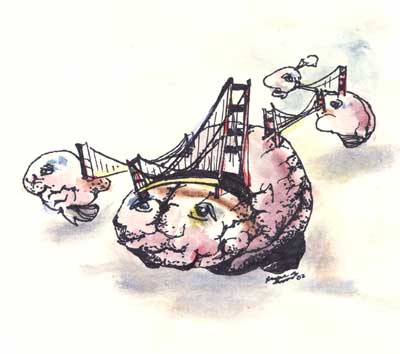
- genes, experiences, culture, individual and story diversity, free will/personal responsiblity
- "I am, and I can think, therefore I can change who I am" (as well as things around me, including culture)
- What do I experience that I can't make sense of? What aspects of stories (mine or other peoples') don't make sense in terms of my experiences?
The brain and education education, a quick summary
Things about the brain that might make one act differently in the classroom
- The brain consists of lots of boxes and cables
- The brain is different in every person
- The brain is constantly changing
- The brain can generate output without input
- The brain is organized to explore by generating expectations and trying out things
- The brain is organized to make informed guesses about what is out there
- The brain consists of a cognitive unconscious and an I-function/story teller
- Perception, self, and memory are all stories, subject to revision based on new observations
- The brain uses conflicts between itself and the world, between the cognitive unconscious and the I-functions/story teller, and between different people to learn by generating new candidate stories
- ???????
Which three of these do you think will be most significant for your teaching this coming year and why? Put your choices, explanation in the forum.
My story, thanks for your contributions to it ...
Whether 'true" in detail or not, for both teachers and students ...
Trust your past (including your genome/culture/experiences), but not too much
Trust your unconscious, but not too much
Trust your thinking, but not too much
Trust making choices, observing, learning, but not too much
Trust other people's stories as well as your own, but not too much
- Choose/act, even if you don't/can't know the "right" answer
- Recognize that disagreement is valuable; you have things to learn from other peoples' stories
- Being wrong is the only way to get it "less wrong"
- Choose/act to see what new things there are to see/do/create



Comments
BBI09 - what I learned (PG)
Lots of things, as always. But what particularly sticks out in my mind/brain are issues of classroom dynamics, and community dynamics generally.
Deb and Jill challenged me on my handling of several occasions of conflict in our conversations, wondering why I hadn't been more active in resolving them. It reminded me of students in my courses who get impatient with the comments of other students, and would prefer that I just get "on with it."
And this, I think, connects to Wil's AH HA moment, when it occurred to him that a classroom/community might be likened to the distributed cognitive unconscious with the teacher as the ... story teller. And that in turn connected (in my mind/brain at least) to the essay that Bharath wrote following one of our conversations. In it, Bharath offered a "balance of stories" model of classroom/community, in contrast to "one story" and "infinite stories" models.
"On the balance of stories model, the readings and the perspective of the teacher provide an initial story for the class. Call this the base story. The teacher lays out the base story as a way of introducing the subject to the students and to have a common vocabulary amongst the teacher and the students ...
[This model] draws a line in the sand at the beginning of the class with the teacher presenting the base story to the students. But unlike the other models, it acknowledges that the classroom is ultimately a place of change, transformation and growth, and that a good class is one which changes through that development. Thus through the oscillations between structure and flexibility, the individual and the social, and teaching and learning, the teachers and the students together erase the line in the sand as the class proceeds ..."
the teacher can’t focus only on the base story all the time because that will curtail the students developing their own interests in the subject. But the teacher also can’t let every student depart wildly from the base story because then the students will find chasms between them when they try to share their interests with each other. Thus as the class develops the teacher must discover through experimentation which interests and the number of interests which best work for the particular dynamic of students she is dealing with ...
the teacher and the students becomes more like colleagues, more like friends, and more like fellow people engaged in a common pursuit of knowledge and a good life."
Bharath's balance of stories model is indeed the way I have come, largely unconsciously, to think of my own classroom, and it is indeed, as Wil suggests, a way of thinking that not only involves a lot of interacting brains but also an overall organization that is itself much like a brain, with interacting diverse "boxes" including a story teller who draws from and returns syntheses back to the other interacting elements ... a story teller that "must discover through experimentation" what stories work and don't work in the particular case at hand.
What additionally amuses me is that I have written about all this in the context of community in general (see The Brain, Story Sharing, and Social Organization), but hadn't myself made the explicit connection to the classroom. So yes, Joyce, there will be a new incarnation of bbi next year (as there always is), one that gives greater attention to classroom dynamics (and hence, of course, less to some other "content").
Maybe more importantly, for me at least, is that I'll be forced myself to take more seriously the differences between a brain and a classroom. A brain has only one "story teller" whereas each component of a classroom (or any human community) consists itself of both a cognitive unconscious and a story teller. What that suggests to me is that a classroom/community should optimally be organized so that everybody becomes not only a better shaper of their own story but also a better contributor to the shaping of collective stories. Maybe its because of that intuition in my unconscious that I sometimes don't play as much of an organizing role in classroom dynamics as some people might prefer? I have in mind that the task is to have experiences that enhance the ability of individuals to recognize that they are responsible not only for their own stories but for the emergence of collective ones as well?
To think more about. In the meanwhile, thanks to all for contributions to my evolution along those lines, and lots of others.
Three Loops
The discussion this morning was quite eye opening for me. I never really thought that deeply about the conscious and the subconscious brain regarding thought, and understanding. I felt our discussion was interesting. The thing that stood out for me was when Paul asked "could you change someone's subconscious thought about something". That was interesting because I do agree if people are open to it then yes, but I also think your life's experiences may sway you to not change your subconscious thoughts...hmmm...
Best part of BBI 2009
Paul, guests, and fellow participants have forever changed my perspective on many issues. It isn't every professional development opportunity that results in my feeling that I know myself better because I have grown more skeptical of my own ideas, have greater clarity about why I teach and what I want learning to look like in the classroom, and provides me with a solid foundation for bringing this knowledge back to school.
I have a new way to think about my classroom. For years, students have developed our class charter and I've only had one "teacher rule" in the room---that no one can get in the way of anyone else's learning. This year I will modify the one teacher rule for the 5/6 grade and clearly articulate it as, no one can get in the way of anyone else's learning, AND each person in the classroom is responsible for the learning of the other members of our classroom community.
I will be creating an interdisciplinary unit of study on the brain and behavior for my 5/6 grade class and will post it on Serendip.
Next Year
In the beginning of the institute, I had an idea that I could help structure my classroom activities and environment to sculpt a comfortable culture conducive to learning. I was disappointed that the idea of brain to culture was addressed at the end and with very little time left to discuss very important connections that we were all making enthusiastically. Please leave more time next year!
Otherwise thanks for a fabulous 2 weeks of learning!"I 'm so glad we had this time together"
"I 'm so glad we had this time together"
A quick summary of the past two weeks
There are some old assumptions that I have gladly dispelled during the course of growing up. The past two weeks has reminded me that it is a way of developing, growing and learning. Keeping stories that work and revising the stories that do not work. As I have learned to be more comfortable with dissonance, and not knowing, search alternative ways to present and assimilate information. The Brain and Behavior Institute is an every changing, microcosm of an emergent culture. As a Christian, I had a difficult time with the secular component to the institute. I continue to remember that I have to bring my culture to the Institute.
What I continue to learn from the institute is to allow myself to emerge personally, and professionally. I am looking forward to how I will change in the next school year, and hope to see and appreciate how I grow and develop.
Last Day of Brain and Behavior
I learned a lot at the Brain and Behavior Institute. I am going to use this emergent learning to enhance my students understanding of their emerging self. They will be able to explore their inner self and try to incorporate what they learned to higher order thinking.
What I liked most about Brain and Behavior!
What I liked most about Brain and Behavior
Paul’s easy teaching style and open-mindedness
Making new friends and working together to grow in our learning – how emergent!
Developing new lessons I can use
THE BRAIN – ever changing!
Culture:Teacher's Pet and ....
Many times the “star student” or “star students” or teacher’s pet are the one who think in similar ways to the teacher. An art teacher would have a very different ‘pet’ than that of the math teacher. This seems to me to have a major connection to the comfort level in this Brain and Behavior Institute, how comfortable are we individually with the emergent environment. I consider the summer institutes as my playground, and can therefore can interact and allow myself to play…say something insightful, or purposefully silly.
Socially, what we consider desirable, we will reward in our social network. What we consider odd, we tend to avoid, personally and professionally. Linguistic people tend to prefer to congregate together, as in book clubs, poetry groups and similar literary partaking.
Bodily kinesthetic people tend seek social connections to others who are similar: i.e. ski clubs, scuba diving club, dancing groups.
Another possible story
When I think about my experiences in book groups, critical friends groups (meeting to discuss classroom practice), other classes, staff meetings, social situations, my own family, my own classroom---what occurs to me is that I don't get energized or experience shifts in my perspective by the people I agree with (sure it can be nice to find a kindred spirit)---but the people who excite me to think, the students who motivate me to be an even better teacher---are the ones who share ideas or behaviors that challenge me to think in new ways.
For me what matters, what I realize I am drawn to in any of the above listed situations, is the energy that I feel from people who are whole heartedly participating in the process. They are present, they are participating in the process of emergent learning...I need to think, as I head back to my own classroom----about how to extend that social contract for learning to all students----how to make sure that everyone in the class knows that they are responsible for everyone else's learning.
quakerism culture
I am interested to hear more about what Deb and Jill have to say about culture and their teaching experiences at a Quaker school. I took a class on Quakerism at Haverford (which is a Quaker school) and we spent a little bit of time talking about consensus. For those that don't know much about it, here is a quote from wikipedia:
"On some occasions a single Friend will hold up a decision because they feel the meeting is not following God's will; occasionally, some members of the Meeting will "stand aside" on an issue, meaning that these members do not share in the general sense of the meeting but are willing to allow the group to move forward."
At Haverford, they make schoolwide decisions by using consensus. To me, it just seems like it takes such a long time to come to a decision. Additionally, isn't one major advantage of culture to have many different viewpoints? By coming to a consensus, I feel like many people just agree with the majority of other people and that many of the views aren't heard because they just want things to move faster. This is just some of my thoughts from the feedback I have gotten from friends at Haverford. Thoughts welcomed.
Consensus
I'm smiling...you brought up the dreaded "c" word. Let's see what I can add to the story--this won't be an exhaustive answer or the answer you will necessarily get from every Quaker--this is just my response, today.
There are many Quakers who will tell you that Quaker process does not include consensus---and they might explain it like this: consensus is about the members making a decision---reaching a consensus is thought to be a secular process. These Friends might go on to explain that instead Friends must be willing to turn decisions over to God/Light/Spirit, allow time and space through worship and meetings for worship with a concern for business---so that they may seek the sense of the Meeting. It is usually a clerk or "weighty" Quaker's role to listen to all spirit led voices and attempt to articulate the sense of the group. It is each members responsibility to engage in the process in a manner that ensures that they both speak their own truth and are open to ongoing revelation--either through their own worship or through the words of another as they share their truth.
There are many Quakers and Quaker orgs that use the "c" word. And Quaker process in our schools is very different from Quaker process in our Meetings, because the schools do have a heirarchy of responsibility.
Visit any historically Quaker institution, like Haverford, and you'll find that most members of the community are not Quaker by birth or practice. Visit any area Meeting and you will find a mix of birthright Quakers, convinced Friends, social/political/secular Quakers, cultural Quakers, Christocentric Quakers, Buddhist Quakers, generally religious Quakers, Universalist Quakers...I could go on. What makes eastcoast Quaker process both challenging and exciting is that in the absence of a clergy, all of these different world views come together in one school or one Meeting to imagine and live in a community that none of them could have imagined alone.
And yes, the process is sometimes messy and time consuming. But it is emergent! Quakers will never be accused of being in a race to "get it right"---our emphasis on ongoing revelation offers a way for us to keep trying to "get it less wrong". I guess that is why the emergence pedagogy resonates so much for me.
If anyone is interested,
If anyone is interested, here is a link to the book Wil was talking about this morning:
http://www.amazon.com/Geography-Thought-Asians-Westerners-Differently/dp/0743216466
I have learned a lot about differences between Eastern (collectivistic) and Western (individualistic) cultures and it is definitely an interesting topic, so I urge you to look into it further!
Individualism vs. Collectivism
Wil brought up the difference in Eastern and Western culture--and this brings me to a common study in psychology, where the Eastern culture is considered collectivist and Western culture is considered more individualistic. It is often found that in individualistic societies, such as in the United States, the importance of family is hierarchically below the importance of self. In a collectivist world, individualistic people are often considered egotistical and selfish. In a collectivist culture, a common "rule of the average" seems to take precedence over individualism, and family is hierarchically more important. However, from the world of the individualists, collectivists seem to have no personal ambitions or pride. Moreover, though, it seems that both of these cultures--while distinctively different--do conform to the story of culture that is mostly agreed upon today: that there is a common thread of knowledge, either collectivism or individualism, that most of the people in the region conform to. Whether or not our own story agrees with a certain culture is irrelevant, and only comes into importance when we are raised in a culture that somehow our brain does not choose to create its' story around: example, Amish culture. The Amish give their children a choice at age 14 to choose the Amish way of life or the more individualistic way of life. Therefore, it is plausible that there is a thread of knowledge in some Amish people that lead them to tell a story in the Amish fashion, and in others, in the individualistic fashion. Once again, we come back to the diverse architecture of the brain.
In Biology 202 with Paul, I took an interest in the other aspect of culture and storytelling: how does culture affect the brain? I did a bit of research on a sect in Brazil, called Capoeira Angola, and their concept of martial arts (which their culture put great emphasis on). This martial arts was completed, most of the time, upon their hands or head--which greatly warped the usual standards of balance. This cultural 'adaptation,' as we may possibly call it, affected the way the brain processed balance. Article: here. In a simplistic way, this type of 'adaptation,' considered cultural, did greatly affect brain architecture whereas those conforming to the Capoeira Angola have diverse ways of balancing as compared to my own culture.
7/17 AM Comments
As in most cases...no job is finished until the paper work is done. So...it stands to reason that this session has these boxes opening as well. :0)
Post new comment